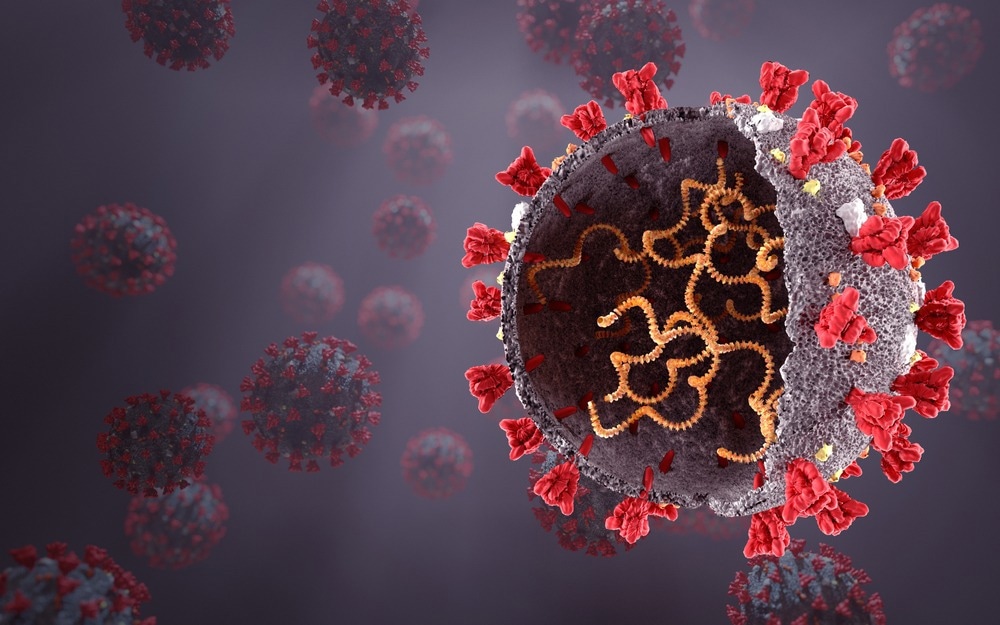Genome packaging is fundamental to successfully transmitting a virus from host to host. The virus's genetic material is tightly folded in a specific way so that it fits neatly into unique packaging laden with cell-grabbing proteins that allow the viruses to invade and establish themselves in a new host. Once inside a host cell, the genetic information unpacks, releasing new viral particles in the new host, allowing the viral infections to grow exponentially.

Image Credit: Orpheus FX/Shutterstock.com
Here, we give an overview of genome packaging in viruses and explore how exploiting this mechanism may prove vital in the fight against future pandemics.
How does genome packaging work?
The viral life cycle depends on a process known as genome packaging. Many viruses proliferate by packing their genomic material into assembled capsids, which then are used to deliver genetic information into a host cell. Without genomic packaging, viruses could not transmit from host to host, spreading infectious diseases, e.g., as we see in the case of the COVID-19 pandemic.
Viruses often use one of two main strategies for viral genome packaging. In the first case, the viruses assemble their capsids around viral genomes. The virus forms a protein capsid shell in the second and then packs its genomes into procapsids. Viruses that use the first method include the ssRNA helical tobacco mosaic virus, ssRNA conical HIV, the ssRNA icosahedral bacteriophage R17, the dsRNA unsegmented icosahedral Totiviridae, and small dsDNA viruses. Those using the second strategy include dsDNA viruses such as tailed bacteriophages and herpesviruses and dsRNA viruses such as φ6 and φ12.
The mode of packaging does not influence the final genome organization, which forms independently of which method was used to pack the genome. The packaged genome shows no apparent order for some viruses, such as icosahedral viruses. Yet in other viruses, such as the plant ssRNA bean-pod mottle virus, the ssDNA bacteriophage φX174, the ssRNA satellite tobacco mosaic virus, and the ssDNA canine parvovirus, the genome assumes a partial icosahedral symmetry in its secondary structure. Systemic layers of packaged DNA are apparent in many viruses, as with many DNA bacteriophages. On the other hand, in many filamentous viruses, the genome is packaged as protein-surrounded helices. Finally, genome packages vary regarding how the virus neutralizes the negative charge. Some viruses, e.g., RNA plant viruses, use polyamines to neutralize the negative charge, whereas others use a capsid protein's positively charged domain to neutralize the charge.
The details of how viruses package viral genomes differ depending on the virus, and until recently, the exact mechanisms of genome packaging were poorly understood. Now, with novel techniques in x-ray crystallography, cryo-electron microscopy (cryo-EM), and single-molecule measurement methods using optical tweezers, we have a deeper understanding of the mechanisms involved in genomic packaging.
This information may prove vital in our efforts to prevent the next pandemic.

Image Credit: sciencepics/Shutterstock.com
The potential role of disrupting genome packaging in preventing future pandemics
The COVID-19 pandemic changed life as we knew it. Unprecedented restraints were forced on social interaction, businesses were closed, travel was suspended, supply chains were disrupted, entire economies came to a standstill, and many lost their lives or became critically ill. Governments, healthcare agencies, researchers, and even laypersons, have a strong interest, therefore, in preventing another pandemic from occurring.
The results of a new Stanford Medicine study have revealed that disruption of genomic packaging may be key to preventing the spread of infectious diseases such as influenza and SARS-CoV-2. The study showed that antiviral drugs that disrupt viral packaging successfully prevent infections.
Because packing strategies are often shared among members of the same viral family, a single antiviral drug can protect against numerous closely-related viruses. For example, influenza A, bird flu, and swine flu are all related so that they can be managed with the same antiviral drug. Treatments that leverage the viral packaging disruption of antiviral agents have the advantage of being unlikely to trigger disease resistance due to the complexity that rearranging genomic packaging would involve.
The study, published in Nature Medicine, describes antiviral treatments that can be tailored to target almost any virus. The study, conducted on mice, hamsters, and human cells in vitro, is yet to be tested in living human patients. However, early evidence suggests that the antivirals will likely be effective at triggering a lasting immune response that protects against subsequent invasions of the targeted pathogen.
The study's results hint that developing a treatment that can rapidly cut off the spread of deadly infectious diseases may be possible. The exciting part is that the antiviral medicine will be able to be manufactured and stockpiled before the next outbreak occurs due to the off-the-shelf nature of the drug design.
Sources:
- Hagey, R.J. et al. (2022) "Programmable antivirals targeting critical conserved viral RNA secondary structures from influenza A virus and SARS-COV-2," Nature Medicine, 28(9), pp. 1944–1955. Available at: https://doi.org/10.1038/s41591-022-01908-x.
- Masters, P.S. (2019) "Coronavirus genomic RNA packaging," Virology, 537, pp. 198–207. Available at: https://doi.org/10.1016/j.virol.2019.08.031.
- Sun, S., Rao, V.B. and Rossmann, M.G. (2010) "Genome packaging in viruses," Current Opinion in Structural Biology, 20(1), pp. 114–120. Available at: https://doi.org/10.1016/j.sbi.2009.12.006.
Further Reading